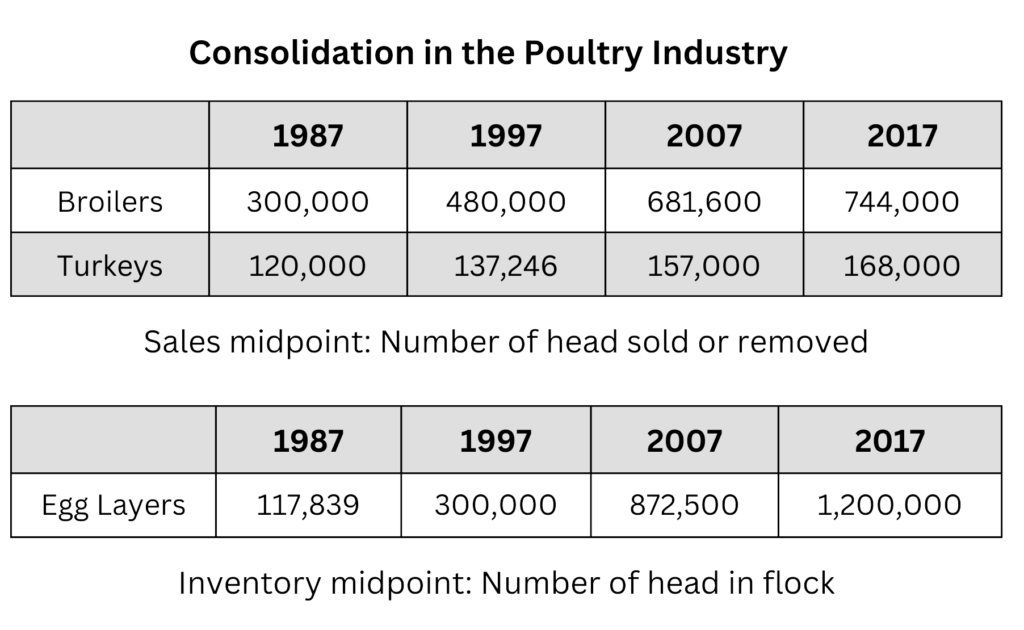1. A typical broiler factory farm sells ~775,000 birds per year, maintaining an inventory of ~135,000 birds.
2. A typical broiler house measures 43’x 500’. The newer large houses can be 39,000 sq. feet – about 70% the size of a football field.
3. Broiler houses hold on average 30,000 – 50,000 birds.
4. The typical number of egg-laying hens on a farm is 1.2 million, with large houses holding 50,000 – 350,000 laying hens.
5. Typical inventory for a commercial turkey farm is ~48,000 birds, with turkey houses likely holding ~19,000 hens or ~8,000 toms.
A typical broiler factory farm sells ~775,000 birds in a year. That is considered the midpoint, meaning that half of all broilers are on farms selling at least that many birds and half are from farms selling less.[1] A broiler is the industry term for a chicken raised for meat.
Referring to the average number of broilers on a farm (rather than typical) would present a misleading picture. A majority of broiler farms sells fewer than 2,000 birds a year. But those farms together produce less than one-tenth of one percent of all broilers.[2] Actual production is steeply tilted towards very large producers, and it is consolidating more each year.
MacDonald, J.M. (2020). Tracking the Consolidation of U.S. Agriculture. Applied Economic Perspectives and Policy, 42(3), 361–379, Table 3, p. 370. [Based on “author’s calculations” and “confidential records” from the 2017 Census of Ag, MacDonald estimates this figure at 744,000. The 2022 Census of Ag shows an increase of about 4% in the average broiler sales per farm for those farms that sell >500,000 broilers per year (making up ~78% of total sales.) Applying a 4% increase to 744,000 gives about 774,000. Since we do not have any info on the distribution of the increase within that largest category of farms, this 4% increase (from 744,000 to 775,000) is our best estimate.]
USDA (2024) 2022 Census of Agriculture, Summary and State Data, AC-17-A-51, Table 30.
[number of broilers sold on farms with < 2000 divided by total number of broilers sold on all farms: 1,880,254 / 9,176,809,391 = .02%]
The typical broiler complex maintains an inventory of ~135,000 birds.[1]
A broiler generally reaches slaughter weight in 47 days.[2,3] There are approximately 5.5 to 6 production cycles per year.[4-7] Assuming a 5.7 cycle, typical inventory would be ~135,000 birds.
This total is likely influenced by the maximum number of broilers that a single contract farmer can profitably manage while limiting the use of outside help.[8]
Calculation: 775,000 birds sold (as above) divided by 5.7 cycles (flocks sent to slaughter) per year.
USDA APHIS (2013) Poultry Industry Manual, Foreign Animal Disease Preparedness & Response Plan (FAD PRep), p. 7.
National Chicken Council (March 2023) U.S. Broiler Performance https://www.nationalchickencouncil.org/about-the-industry/statistics/u-s-broiler-performance/
MacDonald, J.M. (2014) Technology, Organization, and Financial Performance in U.S. Broiler Production, USDA Economic Research Service Information Bulletin No. 126, Table 7, p. 19. [Average flocks per year for all farms = 5.5]
Beal, C. M., et al., (2023). Economic and environmental assessment of US broiler production: opportunities to improve sustainability. Poultry Science, 102(10), 102887, pp. 2-3. [Effort taken to ensure that “model accurately reflects the commercial broiler industry in the United States.” 65-day production cycle and 47 days of growth with 18 days between flocks = ~5.7 cycles per year according to author’s calculation]
Kellogg, R.L. et al., (2014) Estimates of Recoverable and Non-Recoverable Manure Nutrients Based on the Census of Agriculture, USDA Natural Resources Conservation Service, p. 97. [“With time for a partial litter clean-out between cycles and at least one major clean-out a year, six cycles per year was used in this study.”]
This figure is supported by the following calculation based on the 2022 Census of Agriculture:
Broiler inventory = 1,737,674,957 (minus dying before slaughter) = *.95 = 1,650,791,209; 2022 slaughtered and sold = 9,176,809,391 / 1,650,791,209 = 5.6 cycles.Alabama A&M and Auburn Univ. Ext. (2024) New Farmer’s Guide to the Commercial Broiler Industry Farm Types and Estimated Business Returns, p. 4. [“Still, 80,000 to 120,000 square feet of housing for most family farms is all a single farmer can successfully operate while limiting hired labor.” Total square footage times 1.3 birds per sq. ft. = 104,000 to 156,000 birds.]
A typical broiler house measures 43’x 500’. House sizes range from 30-66’ wide and from 300-600’ long. Large houses are 66’ wide by 600’ long – or 39,600 sq. ft.[1-3] This is ~70% of the size of a professional football playing field.
Houses are typically constructed from metal, wood, or a combination of the two.
USDA APHIS (2013) Poultry Industry Manual, Foreign Animal Disease Preparedness & Response Plan (FAD PRep), p. 19.
USDA NASS Agricultural Resource Management Survey – Broiler Highlights. https://www.nass.usda.gov/Surveys/Guide_to_NASS_Surveys/Ag_Resource_Management/ARMS_Broiler_Factsheet/Poultry%20Results%20-%20Fact%20Sheet.pdf [“…the largest new houses were nearly 40,000 square feet (600 by 66).”]
James M. MacDonald (2014) Technology, Organization, and Financial Performance in U.S. Broiler Production, USDA Economic Research Service Bulletin No. 126, p. 19.
There are ~30,000 average-size broiler chickens in a typical size shed (43’ x 500’). A large shed has ~50,000 birds.[1,2] Birds are allocated less than one square foot per bird.
Using the National Chicken Council’s recommended density of 8.5 pounds per square foot for chickens of 5.6 to 7.5 lbs. liveweight. [See NCC (2022) National Chicken Council Broiler Welfare Guidelines and Audit Checklist, p. 12] Per the USDA’s average weight of broiler (6.49 pounds) and a 43’ x 500’ shed with 21,500 square feet, there are (8.5/6.49) = 1.31 birds per sq ft. Multiplying 21,500 x 1.31 = 28,165 birds. For a shed of 66’ x 600’ = 39,600 sq ft x 1.31 birds per sq ft = 51,876 birds in a shed.
Alabama A&M and Auburn Universities Extension (October 20, 2022), New Farmer’s Guide to the Commercial Broiler Industry: Poultry Husbandry & Biosecurity Basics, p.4. [“A modern 60 x 600 foot broiler house may grow 36,000 to 52,000 chickens.” Therefore, a shed 66’ x 600’ would house 39,600 to 57,200 birds.]
In 2011, the average broiler contract grower had 4 broiler houses. Some growers had between 10 and 18 houses.[1,2]
MacDonald, J.M. (2014) Technology, Organization, and Financial Performance in U.S. Broiler Production, USDA Economic Research Service Information Bulletin No. 126, table 3, p. 14.
Univ. of Kentucky, College of Agriculture Extension, Poultry Production Manual, Ch. 2 – Size of Broiler Operations, https://afs.ca.uky.edu/poultry/production-manual
The typical number of egg-laying hens on a farm is 1.2 million. That is the number of hens for which half of all hens in inventory are on farms with at least that many birds, and half are on farms with fewer.[1]
MacDonald, J. M. (2020). Tracking the Consolidation of U.S. Agriculture. Applied Economic Perspectives and Policy, 42(3), 361–379, table 3, p. 370. [Based on “author’s calculations” and “confidential records” from the 2017 Census of Ag, MacDonald estimates this figure at 1.2 million. The 2022 Census of Ag shows a decrease of about 4% in the average laying hen inventory per farm for those farms that had >100,000 hens (making up ~75% of total sales.) It seems likely that instead of a counter-intuitive trend towards less concentration, this is probably a result of the killing of tens of millions of hens due to avian flu. Pending more information, we leave MacDonald’s figure of 1.2 million as the best estimate.]
The largest commercial “in-line” farms (automated egg collection system) can house 6 million laying hens.[1]
USDA, APHIS (2013) Poultry Industry Manual, Foreign Animal Disease Preparedness & Response Plan (FAD PRep), p. 101.
Large houses contain 50,000 to 350,000 laying hens.[1]
The majority of factory farmed hens live in stacked rows of small wire cages. United Egg Producers recommends floor space of 67 to 86 square inches per bird, and 6-7 birds per cage.[2] Sixty-seven square inches is 8.2″ x 8.2″. It has been estimated that a typical commercially raised egg-laying hen would require about 4 times that area to flap her wings.[3]
One construction company that builds cage-free housing for egg-laying hens showcases their facility that holds 2.3 million birds in 6 multi-tier space-age “wrap-the-equipment engineered double-flock layer barns with cool cells.”[4] Each building would contain ~380,000 birds.
USDA APHIS (2013) Poultry Industry Manual, Foreign Animal Disease Preparedness & Response Plan (FAD PRep), p. 102.
United Egg Producers (2021) Hen Housing Diagrams. https://uepcertified.com/wp-content/uploads/2021/08/Hen-Housing-Diagrams.pdf
Mench, J. A., & Blatchford, R. A. (2014). Determination of space use by laying hens using kinematic analysis. Poultry science, 93(4), 794-798, p. 794. [1693 cm2 = 16.2 x 16.2 inches = 262 square inches]
Summit Engineering and Construction, Layers & Pullets, Arizona Layer Complexes, https://www.summitepc.com/egg/layers-pullets
The average number of houses in a large complex is 10, and a complex may consist of 15 houses or more.[1]
USDA APHIS (2013) Poultry Industry Manual, Foreign Animal Disease Preparedness & Response Plan (FAD PRep), pp. 101-102.
The typical farm sells 168,000 turkeys per year.[1] Since farms generally raise about 3.5 flocks per year, a typical inventory level is ~48,000 birds.[2]
MacDonald, J. M. (2020). Tracking the Consolidation of U.S. Agriculture. Applied Economic Perspectives and Policy, 42(3), 361–379, Table 3, p. 370. [That is considered the midpoint – meaning that half of all turkeys are on farms selling at least that many birds and half are from farms selling less.]
USDA APHIS (2013) Poultry Industry Manual, Foreign Animal Disease Preparedness & Response Plan (FAD PRep), p. 53. [This is a broad estimate based on 4 flocks per year for hens and 3 flocks per year for the larger toms – it does not consider the inventory figures for off-site brooding of poults]
Turkey grow-out houses are usually 40-50 ft. wide and 500-700 ft long or 20,000 to 35,000 square feet.[1]
We have very little information about the typical stocking density (space allotment) of turkeys. The National Turkey Federation states that definitive floor space measurement per bird is “not necessarily feasible” but suggests space allotment of 15 lbs. per square foot; thus a 20,000 sq. ft. house would hold ~19,350 hens or ~7,900 toms.[2,3]
Using the USDA’s suggestion that turkeys “receive at least” 2 sq. ft and 3 sq. ft. respectively for hens and toms, a 20,000 sq. ft. house would contain ~10,000 hens or ~6,700 toms.[4]
USDA APHIS (2013) Poultry Industry Manual, Foreign Animal Disease Preparedness & Response Plan (FAD PRep), p. 53.
National Turkey Federation (2012) Animal Care Best Management Practices, p. 46. [“…due to the various production environments and span of bird sizes produced, definitive and quantitative measurements are not necessarily feasible. However, 15 lbs/ ft2 could be used as a measurable standard.”]
National Turkey Federation, Raising America’s Turkeys. https://www.eatturkey.org/raising-turkeys/ [“A hen usually takes 14 weeks and weighs 15.5 pounds when processed, but a tom takes roughly 18 weeks to reach a market weight of 38 pounds.”]
USDA APHIS (2013) Poultry Industry Manual, p. 63.
From 1987 to 2017, broiler sales per farm have more than doubled. Egg-laying hen inventories have multiplied by more than a factor of ten.

“Housing units became larger and more tightly enclosed, with improved climate control and feeding equipment, and contract growers placed more houses and animals on their facilities.”[1]
MacDonald, J.M. (2020). Tracking the Consolidation of U.S. Agriculture. Applied Economic Perspectives and Policy, 42(3), 361–379, table 3, p. 370.
